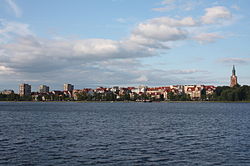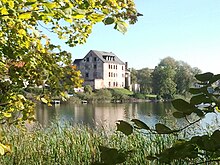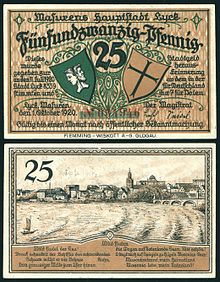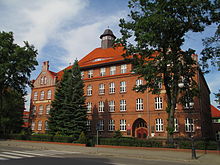| Revision as of 18:38, 8 May 2019 editPavKls (talk | contribs)Extended confirmed users27,199 edits →Districts← Previous edit | Revision as of 18:39, 8 May 2019 edit undoPavKls (talk | contribs)Extended confirmed users27,199 edits →High schoolNext edit → | ||
| Line 222: | Line 222: | ||
| ==High school== | ==High school== | ||
| ] |
] No. 1 in Ełk]] | ||
| * | * | ||
| * | * | ||
Revision as of 18:39, 8 May 2019
Place in Warmian-Masurian Voivodeship, Poland| Ełk | |
|---|---|
 View of Ełk across the Ełk Lake View of Ełk across the Ełk Lake | |
 Flag Flag Coat of arms Coat of arms | |
  | |
| Coordinates: 53°49′17″N 22°21′44″E / 53.82139°N 22.36222°E / 53.82139; 22.36222 | |
| Country | |
| Voivodeship | |
| County | Ełk County |
| Gmina | Ełk (urban gmina) |
| Established | 1237 |
| Town rights | 1445 |
| Government | |
| • Mayor | Tomasz Andrukiewicz |
| Area | |
| • Total | 22.07 km (8.52 sq mi) |
| Population | |
| • Total | 61.523 |
| • Density | 2.8/km (7.2/sq mi) |
| Time zone | UTC+1 (CET) |
| • Summer (DST) | UTC+2 (CEST) |
| Postal code | 19-300 |
| Area code | +48 87 |
| Car plates | NEL |
| Website | http://www.elk.pl |
Ełk (Template:Audio-de; Old Prussian: Luks; Template:Lang-lt; before 1939 rendered in Polish as Łęg or Łęk) is a town in northeastern Poland with 61,156 inhabitants (as of 2010). It was assigned to Warmian-Masurian Voivodeship in 1999, after belonging to Suwałki Voivodeship from 1975 to 1998. Ełk is the capital of Ełk County. It lies on a shore of Ełk Lake, which was formed by a glacier, and is surrounded by forests. It is the largest city, and according to many, the capital of the region of Masuria. One of its principal attractions is hunting, which is carried out in extensive forests.
History


By 1283, the last Sudovian Prussian leader, Skomand (Lithuanian: Skalmantas), capitulated to the Teutonic Knights in the area. After 1323, the northern part of the region was administered by the Komturship of Brandenburg, while the larger part with the later town belonged to Komturship Balga. A former Old Prussian settlement, the town was first documented in 1398 around a castle built by the Teutonic Knights. The town's name has various postulated origins. Its German version Lyck is postulated to be derived from its Old Prussian name, Luks (from the word for waterlily, luka), while another theory holds that the name comes from Polish word "łęg" meaning meadow. It received its town rights in 1445.
In 1537, Duke Albert of Prussia donated an estate to Jan Malecki, a Polish printer from Kraków who had either fled or moved to Ducal Prussia (at the time a fief of Poland) for material reasons, to establish a printing house. After converting to Lutheranism, Malecki translated and published Martin Luther's Small Catechism in Polish In 1546 the first school for secondary education in Masuria was founded in the city, where Polish nobles from the Polish–Lithuanian Commonwealth, as well as Germans from Ducal Prussia were taught in Polish; the position of a Polish teacher remained in place until 1819.
In 1709-10, the plague claimed 1,300 victims. In 1831, 300 people, about 10 percent of the populace, died of the cholera, in 1837 another 80 and 333 in 1852.
In 1825, Lyck was inhabited by 1,748 Germans and 1,394 Poles. At the beginning of the 19th century, a Polish-language school was organised in the city by Tymoteusz Gizewiusz In 1820, Fryderyk Tymoteusz Krieger became the superintendent of the school and actively defended the rights of local Poles to use the Polish language. Kireger also prepared Polish educational programs, in opposition to attempts at Germanization by Prussian authorities.
In 1840, the German-language newspaper "Lycker gemeinnütziges Unterhaltungsblatt", later called "Lycker Zeitung", was founded. Between 1842 and 1845, a Masurian newspaper "Przyjaciel Ludu Łecki" (Łek's Friend of the People) was printed in the city, whose aim was to resist Germanisation and cultivate Polish folk traditions as well as educate the local rural population

In May 1845, a Polish resistance movement in the city was organized by Kazmierz Szulc, whose aim was to prepare local Polish youth for an uprising.
From 1896 to 1902, "Gazeta Ludowa", a Polish-language newspaper, heavily subsidised by banks from Greater Poland representing the Polish national movement in Masuria, was published in the city. It soon faced repression and discrimination from the German authorities which led to its demise; its paid circulation dropped from 357 copies in 1896 to less than 250 at the turn-of-the-century. According to German-American author, Richard Blanke, the "demise marked the end of the second major effort by Polish nationalists to establish a journalistic foothold in Masuria".

In 1896, Polish and Masurian activists founded the Masurian People's Party in the city, which sought to resist efforts of German authorities at forced Germanization. The co-founder of the party was poet Michał Kajka, today honoured in Ełk with a monument in the centre of the city. From the start, the party was subject to severe repressions and attacks by Prussian authorities. In the German federal elections, the MPL received 229 votes in 1898 and 20 in 1912 in the Lyck constituency.

In 1910, Lyck had more than 13,000 inhabitants. Mateusz Siuchniński gives the percentage of Poles in 1900 as 35.7% but warns that the numbers come from lowered German estimates. Many citizens fled during World War I, when Imperial Russian troops attacked the region, but returned after the battles of Tannenberg and the Masurian Lakes. English and Italian troops were deployed in the town after the Treaty of Versailles to supervise the East Prussian plebiscite, which resulted in 8,339 votes for Germany and 8 for Poland.
It was in Lyck that the first-ever weekly newspaper in the Hebrew language, Ha-Magid ("the preacher") was founded in 1856 by Eliezer Lipmann Silbermann, a local rabbi. The paper was eventually moved to Berlin. In Weimar Germany anti-Semitism became prevalent, which led to persecution of the local Jewish population even before the Nazis took power. An anti-Semitic publication, Die jüdische Überlegenheit (The Jewish Supremacy) attacking the Jews circulated in 1927 at a local gathering of fascist sympathizers In 1932, the local pharmacist Leo Frankenstein was attacked; a hand grenade was thrown into his home. The wave of anti-Semitic repressions intensified after Nazis gained power in Germany in 1933 and many local merchants and intellectuals of Jewish descent were arrested. During Kristallnacht, Jewish shops and synagogue were plundered and devastated in the town. Facing these events, several Jews of Lyck decided to escape, some abroad, some to Berlin, others as far as Shanghai Of those Jews who remained, 80 were murdered in various Nazi concentration and death camps.

The city also was site of prison camps for Norwegian and Soviet PoWs during World War II. It was heavily damaged by bombardments. The county of Lyck had 53,000 inhabitants when the Soviet Army approached in January 1945. The town was placed under Polish administration in April 1945 and its German inhabitants were dispossessed and forcibly expelled. It was rebuilt and renamed Ełk (before 1939, Polish names for the town included Łęg and Łęk). In 1999, Ełk was visited by Pope John Paul II. About 300,000 people attended a papal Mass.
Population

Number of inhabitants by year
| Year | Number |
|---|---|
| 1499 | 600 |
| 1600 | 800 |
| 1782 | 2,000 |
| 1831 | 2,945 |
| 1875 | 5,912 |
| 1880 | 6,846 |
| 1890 | 9,981 |
| 1925 | 15,159 |
| 1933 | 15,512 |
| 1939 | 16,243 |
| 2010 | 61,156 |
| 2011 | 59,274 |
| 2017 | 61,523 |
Note that the above table is based on primary, possibly biased, sources:
Demographic changes 1910 – 2013

Districts

The city of Ełk is divided into 13 administrative units, known in Polish as osiedla
- Baranki
- Centrum
- Jeziorna
- Konieczki
- Osiedle Bogdanowicza
- Osiedle Grunwaldzkie
- Osiedle Kilińskiego
- Osiedle Wczasowe
- Pod Lasem
- Północ I
- Północ II
- Szyba
- Tuwima
- Zatorze
Notable residents
- Eliezer Lipmann Silbermann (1819–1882), Jewish publisher
- Arthur Ludwich (1840–1920) a German classical philologist who specialized in Homeric studies
- Charles Edward Moldenke (1860–1935) was an American Lutheran minister and Egyptologist
- Theodor Simon Flatau (1860–1937), German physician
- Karol Bahrke (1868–1935), Polish activist, journalist and book publisher
- Otto von Schrader (1888–1945), German admiral
- Theodor Horydczak, (1889-1971), American photographer
- Alfred Müller (1905–1959) a German middle-distance runner, competed in the 1928 Summer Olympics
- Kurt Symanzik (1923–1983), German physicist
- Siegfried Lenz (1926–2014), German author, born in Lyck; honorary citizen of Ełk since 2011.
- Klaus Gerwien (born 1940), German soccer player
- Leszek Błażyński (1949–1992), Polish boxer
- Roman Czepe (born 1956), Polish politician
- Andrzej Zgutczyński (born 1958), Polish footballer
- Cezary Zamana (born 1967), Polish cyclist
- Michał Olszewski (born 1977), Polish author
- Paweł Sobolewski (born 1979), Polish footballer
Mayors
- Adam Puza (1990–1994)
- Zdzisław Fadrowski (1994–2002)
- Janusz Nowakowski (2002–2006)
- Tomasz Andrukiewicz (since 2006)
Education

- Private Economic Academy
- Nursery School
- Higher Catholic Seminary
- University of Warmia and Mazury in Olsztyn
- Academy of Finance and Management in Białystok
- University of Economy in Bydgoszcz
High school

- Zespół Szkół Ekonomicznych
- Zespół Szkół Mechaniczno - Elektrycznych
- Zespół Szkół nr 1
- Zespół Szkół nr 2 im. K. K. Baczyńskiego (swww)
- Zespół Szkół nr 3 im. J. H. Małeckich (www)
- I Liceum Ogólnokształcące im. S. Żeromskiego (www)
- Zespół Szkół Rolniczych im. M. Rataja
- Zespół Szkół Samorządowych
- Zespół Szkół nr.6 im. M. Rataja (www)
Religion

Before World War II, the town and its surroundings were almost entirely (>95%) Lutheran. After the German populace fled or was expelled, the main religion in Ełk became Roman Catholicism, although a number of Protestant churches are also represented and play an important role in the religious life of the population. These include the Methodist, Baptist, Pentecostal (Assemblies of God - Kościół Zielonoświątkowy) and other churches. Ełk is the center of the Catholic Diocese of Ełk with its bishop Jerzy Mazur.
International relations
See also: List of twin towns and sister cities in PolandTwin towns and sister cities
Ełk is twinned with:
 Hagen, Germany
Hagen, Germany Lida, Belarus
Lida, Belarus Nettetal, Germany
Nettetal, Germany Nemenčinė, Lithuania
Nemenčinė, Lithuania Burlington, Vermont, United States
Burlington, Vermont, United States Galatone, Italy
Galatone, Italy Orbassano, Italy
Orbassano, Italy Ozyorsk, Russian Federation
Ozyorsk, Russian Federation
Coat of arms

The current coat of arms of Ełk were adopted in 1999, after the town was visited by the Pope John Paul II. The colors have been changed (from green to yellow), the deer is different than in the former emblem. Lastly is the addition of the insignia of the Papacy.
Until 1967, a different emblem with the two-faced head of the god Janus was used, but its origin is unknown.
Gallery
-
Art school
-
Baptist church
-
 Town hall
Town hall
-
District court building
-
 Bridge on the Ełk Lake
Bridge on the Ełk Lake
-
Ełk railway station
-
The Ełk narrow gauge railway station
-
 Michał Kajka monument in Solidarity Park
Michał Kajka monument in Solidarity Park
-
 Ełk bypass route
Ełk bypass route
-
City Stadium
References
- Program Rewitalizacji Ełku, page 20 Załącznik nr 1 do Uchwały Nr LIII/493/10 Rady Miasta Ełku z dnia 25 maja 2010 roku
- Kossert, Andreas (2005). Ostpreussen – Geschichte und Mythos (in German). Siedler. p. 60. ISBN 3-88680-808-4.
Seit 1537 entfaltete der aus Polen geflüchtete protestantische Pfarrer Jan Maletius eine rege Übersetzungstätigkeit in Lyck
- Frick, David (1989). Polish Sacred Philology in the Reformation and the Counter-Reformation: Chapters in the History of the Controversies (1551-1632). University of California Press. p. 13. ISBN 0520097408.
- *Popp, Dietmar; Suckale, Robert (2002). Die Jagiellonen: Kunst und Kultur einer europäischen Dynastie an der Wende zur Neuzeit (in German). Germanisches Nationalmuseum. p. 205. Retrieved 30 January 2012.
*Hołd pruski Maria Bogucka, Wydawnictwo Interpress, p. 137, 1982.
*Archiwa, biblioteki i muzea kościelne, Tomy 69-70 Katolicki Uniwersytet Lubelski. Ośrodek Archiwów, Bibliotek i Muzeów Kościelnych, page 131 1998 - Jakobson, Roman (1985). Selected Writings: Early Slavic Paths and Crossroads. Walter de Gruyther. p. 51. ISBN 3-11-010605-1. Retrieved 30 January 2012.
- Dzieje Warmii i Mazur w zarysie, Tomy 1-2 Jerzy Sikorski, Stanisław Szostakowski, Ośrodek Badań Naukowych im. Wojciecha Kętrzyńskiego w Olsztynie Państwowe Wydawnictwo Naukowe, page 190, 1981
- Kossert, Andreas (2006). Masuren. Ostpreußens vergessener Süden (in German). Pantheon. ISBN 3-570-55006-0.
Kossert, Andreas (2004). Mazury, Zapomniane południe Prus Wschodnich (in Polish). ISBN 83-7383-067-7. - Kossert, Andreas (2001). Masuren - Ostpreussens vergessener Süden. p. 132. ISBN 3-570-55006-0.
- Historia Pomorza:(1815-1850), Gerard Labuda, Poznańskie Towarzystwo Przyjaciół Nauk, page 157, 1993
- Karty z dziejów Mazur: wybór pism, Tom 1 Emilia Sukertowa-Biedrawina Pojezierze, page 68, 1972.
- Tadeusz Oracki, page 173, Instytut Wydawniczy Pax, 1983.
- Weber, Reinhold (1983). Masuren: Geschichte, Land und Leute (in German). Rautenberg. p. 200. Retrieved 30 January 2012.
- Wielka encyklopedia powszechna PWN: Polska-Robe Bogdan Suchodolski, Państwowe Wydawnictwo Naukowe, page 566, 1967
- Koncepcje i rozwój literatury dla ludu w latach 1773–1863 Eugenia Sławińska, Wyższa Szkoła Pedagogiczna w Bydgoszczy, page 45 1996
- Rocznik gdański, Tom 48, Wydanie 2 Gdańskie Towarzystwo Naukowe, Gdańskie Towarzystwo Naukowe. Wydział I--Nauk Społecznych i Humanistycznych Gdańskie Towarzystwo Naukowe, page 73, 1990
- Blanke, Richard (2001). Polish-speaking Germans? Language and national identity among the Masurians since 1871. Böhlau. p. 65. ISBN 3-412-12000-6.
- Kossert, Andreas (2001). Masuren - Ostpreussens vergessener Süden (in German). Siedler. p. 210.
1896 wurde die Gazeta Ludowa (Volkszeitung) gegründet, die zum großen Teil von Banken aus Großpolen massiv unterstützt wurde. Nach einem Jahr hatte die hochsubventionierte Zeitung eine auflage von 2500 Exemplaren erreicht
- Zarys historii polskiego ruchu ludowego: makieta: Tom 1 Zjednoczone Stronnictwo Ludowe. Naczelny Komitet. Zakład Historii Ruchu Ludowego, Stanisław Kowalczyk, Józef Kowal, page 223- 1963
- Szkice z dziejów Pomorza: Pomorze na progu dziejów najnowszych, Gerard Labuda Książka i Wiedza,"12.Gazeta Ludowa w Ełku", page 303 1961
- Richard Blanke:"Polish-speaking Germans", pages 68, 72
- Richard Blanke:"Polish-speaking Germans", page 73
- *
*Mały słownik historii Polski Witold Sienkiewicz Wiedza Powszechna, page 59, 1991
*Nowa encyklopedia powszechna PWN, Tom 4, Barbara Petrozoliń-Skowrońska Wydawnictwo Naukowe PWN, page 136 1996 - Kraj a emigracja: ruch ludowy wobec wychodźstwa chłopskiego do krajów Ameryki Łacińskiej (do 1939 roku) Jerzy Mazurek, page 281, Biblioteka Iberyjska, 2006
- Richard Blanke:"Polish-speaking Germans", p. 71.
- Andreas Kossert: Masuren - Ostpreußens vergessener Süden, page 33
- Miasta polskie w tysiącleciu: Tom 1 Mateusz Siuchniński - Zakład Narodowy im. Ossolińskich, page 275 1965
- Butler, Rohan, Massachusetts., Bury, J.P.T., MA., & Lambert M.E., MA., editors, Documents on British Foreign Policy 1919-1939, 1st Series, Her Majesty's Stationery Office, London, 1960, vol.x, Chapter VIII, "The Plebiscites in Allenstein and Marienwerder January 21 - September 29, 1920"
- ^ Historical Jewish Press website; retrieved May 21, 2014.
- Archived 2016-03-09 at the Wayback Machine Virtual Sztetl
- ^ Ełk History
- Teczka specjalna J.W. Stalina:raporty NKWD z Polski 1944-1946, page 159 Instytut Studiów Politycznych Polskiej Akademii Nauk, 199
- Cudzoziemcy w polskim ruchu oporu: 1939-1945, Stanisław Okęcki, page 136 "Interpress,"
- Template:Pl icon
- Template:Pl icon
- August Eduard Preuß: Preußische Landes- und Volkskunde. Königsberg 1835, pp. 454–455, no. 65.
- wspolczesna.pl Template:Pl icon
- Johann Friedrich Goldbeck: Volständige Topographie des Königreichs Preussen. Part I: Topographie von Ost-Preussen, Marienwerder 1785, p. 39, no. 2.
- "Siegfried Lenz zum Ehrenbürger seiner Geburtsstadt ernannt" (in German). Hamburger Abendblatt. Retrieved 2011-11-18.
- historical religious statistics at verwaltungsgeschichte.de
- "Ełk - Przedwojenny herb miasta". Castles of Poland. 2003-04-30. Retrieved 2009-05-05.
External links
- Municipal website Template:Pl icon
- Ełk information Template:Pl icon
- Historical postcards from Lyck (Ełk)
- Google satellite photo
53°50′N 22°21′E / 53.833°N 22.350°E / 53.833; 22.350
| Gminas of Ełk County | ||
|---|---|---|
| Seat: Ełk (urban gmina) | ||
| Rural gminas |  | |
